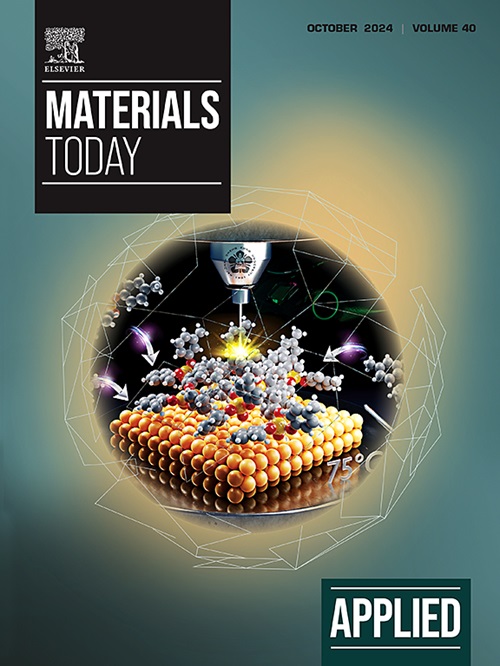Harvesting of shear piezoelectricity in a molded multicomponent crystal disc
IF 6.9
2区 材料科学
Q1 MATERIALS SCIENCE, MULTIDISCIPLINARY
引用次数: 0
Abstract
Biomolecular piezoelectrics, such as amino acids and peptides, exhibit significant shear piezoelectric responses in single crystal form. However, naturally occurring longitudinal piezoelectricity is rare and, when present, is dampened due to the multi-directional self-assembly in polycrystalline device layers. Here we utilise cocrystallisation to engineer a multicomponent crystalline salt hydrate of (+)Mandelic Acid and LLysine, (). This material exhibits a predicted single crystal longitudinal piezoelectric response of d = 3.5 pC/N. In polycrystalline form, grows as an assembly of plates which increases the measured longitudinal piezoelectricity to 11 pC/N in its macroscopic solid-state. This is due to contributions from the shear piezoelectric response d = 10.8 pC/N, originating from the presence of plates oriented at acute angles relative to the surface. The brittleness of the crystals ( = 37 GPa) is overcome by reinforcing the substrate-free piezoelectric disc with a thin polymer coating to prevent flaking. Structural analysis confirms that the triclinic structure of gives rise to this increased response due to the relative orientations of individual crystallites. Confined crystallisation of this multi-component form with a plate-like morphology, results in macroscopic self-assembly of an amino acid cocrystal that allows for the harvesting of higher shear piezoelectricity, but in a facile longitudinal configuration.在模制多组分晶体盘中采集剪切压电效应
氨基酸和肽等生物分子压电体在单晶形式下表现出显著的剪切压电响应。然而,天然存在的纵向压电现象非常罕见,即使存在,也会因多晶器件层中的多向自组装而受到抑制。在这里,我们利用共晶技术,设计出了(+)扁桃酸和 LLysine 的多组分结晶盐水合物()。这种材料显示出预测的单晶纵向压电响应 d = 3.5 pC/N。在多晶形态下,它生长为一个板组件,在其宏观固态下,测量到的纵向压电性增加到 11 pC/N。这是由于剪切压电响应 d = 10.8 pC/N 的贡献,而剪切压电响应是由于相对于表面成锐角的板的存在而产生的。晶体的脆性(= 37 GPa)可通过在无基底压电圆盘上加固一层薄聚合物涂层来克服,以防止剥落。结构分析证实,由于单个晶体的相对取向,三菱结构导致了响应的增加。这种具有板状形态的多组分限制结晶导致了氨基酸共晶的宏观自组装,从而可以获得更高的剪切压电性,但只能以简单的纵向配置获得。
本文章由计算机程序翻译,如有差异,请以英文原文为准。
求助全文
约1分钟内获得全文
求助全文
来源期刊

Applied Materials Today
Materials Science-General Materials Science
CiteScore
14.90
自引率
3.60%
发文量
393
审稿时长
26 days
期刊介绍:
Journal Name: Applied Materials Today
Focus:
Multi-disciplinary, rapid-publication journal
Focused on cutting-edge applications of novel materials
Overview:
New materials discoveries have led to exciting fundamental breakthroughs.
Materials research is now moving towards the translation of these scientific properties and principles.
 求助内容:
求助内容: 应助结果提醒方式:
应助结果提醒方式:


